Reader Benefits READER-CENTERED WRITING
Developing Reader Benefits
Reader Benefits are benefits or advantages your audience gains from complying with a request or policy, using your services, buying your product, adopting your ideas, or generally, doing a thing they might not be excited about doing. Reader benefits can be extrinsic or intrinsic. Read more on extrinsic vs. intrinsic in the persuasive contexts notes, or in these outside resources: “Extrinsic and Intrinsic Reader Benefits” and “Intrinsic and Extrinsic Rewards with Examples.”

Good Reader Benefits
In general, good reader benefits are:
- adapted to the audience
- phrased in reader-centered language (You-View/You-Attitude)
- “frontloaded” at the beginning of a sentence (or a document) rather than included at the end
- demonstrate value to reader (includes what reader values most, e.g., saving money vs. saving time)
- are phrased in the reader’s language
Think about reader benefits as if they were currency. Currency has value, but only if two parties share the same system of monetary value. Sure, you figure out exchange rates, or go to a bank for currency exchange, but that’s a lot of effort—especially when you’re not sure if the effort is worth the value. (According to The Guardian, Zimbabwe’s hyperinflation reached 500 billion percent in 2008. That means $1 USD = 35 quadrillion Zimbabwean dollars. A million dollar Zimbabwean bank note wouldn’t be worth a trip to the bank.)
So, not only should you speak in your audience’s currency, but also in the language of their values. A few hypotheticals:
Reader’s Language Hypotheticals
Chris’s Home Haircut: Style vs. Savings
Chris is a third year graduate student living on a small stipend and student loans. He doesn’t care about having a trendy hairstyle, so he gives himself a buzz cut once a month to save money—it’s not the most flattering hairstyle for him, but it’s neat. To Chris, saving money is worth more than having a flattering hairstyle (and the money he saves is also worth the mess he has to clean up).

Nicole’s No Coupons: Savings vs. Time
Nicole is mother to two five year old twins. Since both she and her partner work full time, they aren’t living paycheck to paycheck, but they aren’t making much disposable income to waste on entertainment. They don’t go out to see the latest releases at the movie theater, and they don’t dine out. However, Nicole doesn’t ever clip grocery coupons, look for buy-one-get-one specials, or store sales. She just goes to the grocery store and gets the items on her list, no matter how much they cost. Nicole has decided it’s not worth the time it takes to read grocery store mailers, search for online coupons, and compare prices. The extra time she gets to spend with her family is worth more than the money she could potentially save.
Evan’s Weekend Theater: Money vs. Fulfillment
Evan decided to fulfill a lifelong dream of joining a community theater troupe in his 40s. Because he has theater practice, he no longer spends extra hours at work and no longer works from home on the weekends. For that reason, Evan loses commission money each month. He’s willing to make less money because it allows him to participate in a hobby he enjoys.
Your $1.50: Time? Money? Coffee? Snack? Fun? …?
Currency is one thing (who doesn’t like to save money?), but value (and values) is another.
What is $1.50 worth to you? Is it a snack or a cup of coffee between classes? Is it extra time on the parking meter? Is it an app or an ebook? Is it a single cheeseburger at the drive through, is it a tip for your barista, or is it a lottery ticket just for fun?
Features vs. Benefits: Phrase Reader Benefits in Reader’s Language
Reader benefits are what the reader will get out of the situation. Emphasizing reader benefits can help convince our readers to do whatever it is we’re asking them to do because they tell our readers how they will be positively affected by doing business with us (or whatever the situation may be).
Not only should we emphasize the benefits to our readers, but also, we should ensure we write in language that means something to them — in language that is useful and language that speaks to their values.
Keep in mind, there’s a difference between features and benefits. Features are writer-centered (or product/service-centered). Benefits are reader-centered.
| instead of: | revise to reader benefits (in the reader’s language): |
|---|---|
| No money down, no interest payments for 24 months | You can get what you want right now at no cost to you… [additional details to explain and maintain good ethics] |
| This printer prints 17 pages per minute. | This printer can turn out a 100 page, full color proposal in just six minutes. |
| Our tablet boasts an impressive 32 gb of space and file transfer speeds of 100 Mbps. | You have room for six full-length HD films and can download a whole movie in under seven minutes. |
| Our shelter provides 100 adult beds and 50 children’s beds for the needy. | Your donation will help provide temporary housing to women and children, keeping them off the streets and out of abusive living situations. |
| We want all newly hired employees to use our carpooling program for at least three months. | As a new employee, you won’t have to drive to work in rush hour traffic for the first three months with our carpooling program. |
| We have invested a lot of money to build the biggest grocery store in town. | You can choose from the largest selection fresh fruits and vegetables, shelf staples, and specialty gourmet items thanks to Publix large inventory. |
Extrinsic vs. Intrinsic Benefits
Extrinsic Benefits
Intrinsic Benefits
| extrinsic: | intrinsic: |
|---|---|
| Train hard so you can win the race. (winning—being faster than others or winning a medal/prize—has no essential connection to the race itself) | Train hard so you can finish the marathon. (to feel a sense of accomplishment) |
| Recruit 100 additional clients and receive a holiday bonus payment. (a monetary payment is a bonus) | Recruit 100 additional clients and be recognized for your contribution to the company. (to feel valued) |
| Graduate with honors and I’ll buy you a car. (a car has nothing to do with graduating with honors) | Graduate with honors to demonstrate your work ethic and intelligence. (because being smart/education is useful, valuable) |
| Come to work on time everyday for three months and you’ll earn a paid day off. (a paid day off is an external or extra reward) | Come to work on time everyday so we can all get an early start on our projects. (to feel accomplishment; feel like part of a team) |
| Drink Lean Green Smoothies and look ten years younger. (looking younger is an added benefit—an extra effect—of increased health) | Drink Lean Green Smoothies and be healthy. (health is inherently valuable) |
Avoid Negative vs. Get Positive
- Reader benefits—both positive outcomes and potentially negative outcomes to avoid—are important in all types of professional contexts—informational/positive, negative, and persuasive
- If a situation includes a potentially negative outcome to be avoided,
- consider whether the negative is artificial or made up, and also
- consider whether there is a positive outcome involved, too
- Often, the positive outcome is a rationale (or purpose) for an action, guideline, rule, policy, or procedure
- Sometimes, the positive outcome is a little dull, unexciting, etc. Put another way, the reader benefit isn’t often free money, a great coupon, a fantastic something-or-other, etc.
- students’ schedules are established from the very start of the term (for time management; development of a routine; understanding of workloads and expectations…. ultimately, so students have the best chance of success)
- students’ get any/all valuable information and instruction delivered during the first week of class (for similar reasons as above, and ultimately, for students’ success)
- departments and professors can offer classes students need/want in regular rotation; this will help students know what classes are usually offered and in what rotation, helping them to plan their semester’s in advance and ultimately allowing students to graduate on-time (which is good for FAU’s metrics and helps students to avoid surplus credit charges and overload fees)